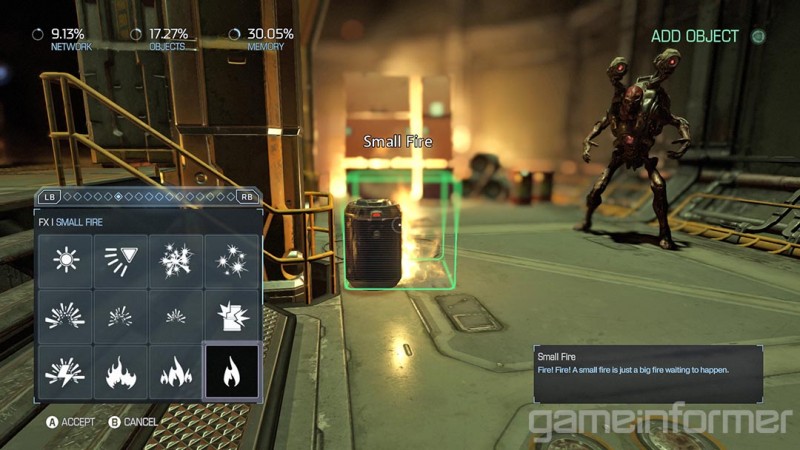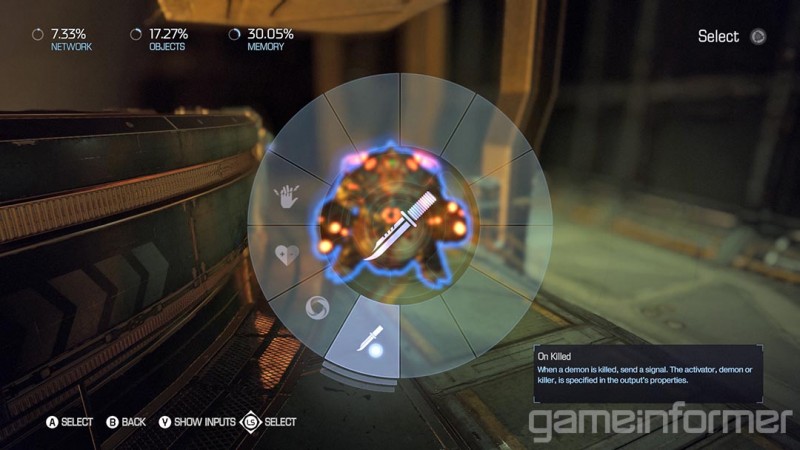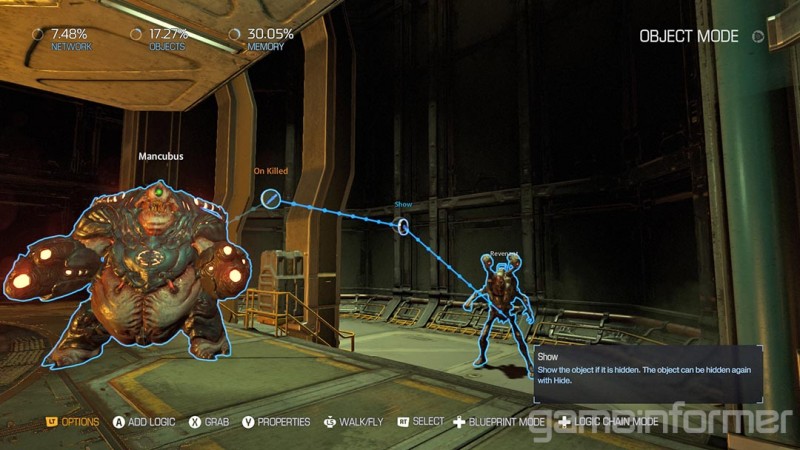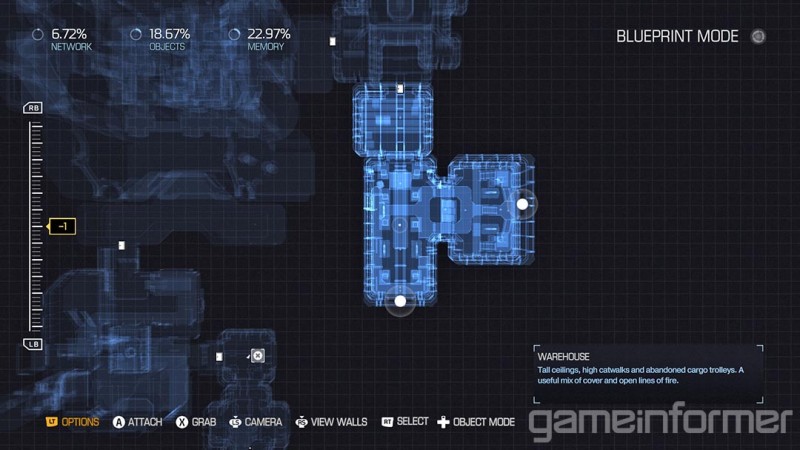Hands On With Doom's SnapMap
Id Software has released the source code for most of its games dating back to the original Doom, granting PC players the means to create their own maps, modes, and mods. Even with no defined set of rules as to how content could be created and shared, Doom's modding community erupted in popularity and became a movement in video games. As you'll soon learn, the skills tied to creating levels helped people land legitimate jobs in game development. The modding scene is a vital part of what Doom is, but it isn’t something anyone can freely jump into. It's a time commitment and a skill-based endeavor that relies heavily on technical know-how and artistic abilities. SnapMap changes all that.
Within this spring’s upcoming Doom reboot, id Software is inviting everyone to try building a map – whether you've messed around with game modding before or simply play games casually. If SnapMap works as intended, anyone can create a map within minutes of trying it for the first time. As id representatives said over and over again during our visit to the studio, building a map is as easy as snapping Lego bricks together.
Id designed the tools with simplicity in mind, but in doing so, is greatly limiting what the mod community can do with the game. Unless id announces wider plans for the PC version post-launch, creators won’t be able to import their own art or tweak the game’s code in anyway. Instead, everything must be made using just the components id Software provides. The benefit of using the tools provided is that everyone has the same parts to play with, and nothing else needs to be uploaded or downloaded other than a small instruction file. This means maps can be shared and played in the amount of time it takes to load a level.
Id is creating SnapMap in conjunction with Escalation Studios, a team of video game veterans that is well versed in the modding community and working with large, triple-A projects.
“This is something I’ve been wanting to do my entire life. I knew this since I began working on Doom mods in 1994,” says Tom Mustaine, Escalation’s president and co-founder. “Doom started the juices for me when I was very young. I remember playing the game and running around a corner to a staircase and saying ‘I have to figure out how to make maps in this engine.’ I pushed and pushed and pushed. Back then it was extraordinarily hard to [make content] – using DOS and finding things on BBS’ and websites and the whole nine yards. I figured out how to make a ton of maps back in the day. I actually helped build Final Doom for id.”
When compared to other games featuring content-creation modes like LittleBigPlanet, Project Spark, Super Mario Maker, or even TimeSplitters, Mustaine insists Doom is different from anything else on the market. “I think [SnapMap] is the first of its kind,” he says. “It’s a full in-game tool that, regardless of the platform, you can create content and share it with your friends and publish it to the world for multiplayer, co-op, and single-player. You can also make stuff that is just fun.”
Rather than walking me through how SnapMap works, Mustaine instead tells me to pick up the controller to experience the mod tools for myself. He says that I’ll be able to build something within a mater of minutes.
Before I get started, Marty Stratton, id Software’s game director and executive producer, clarifies that these tools were not used by his team for the creation of the single-player game. “[SnapMap] is a separate tool that is specifically created for consumers and using console controllers,” he adds. “It’s not built to mod the game in a traditional sense. You’re not going to mod the game experience. It’s really about creating new content with the pieces and parts. We dump a pile of Legos in front of you.”
Mustaine and Stratton don’t want to shepherd my time in SnapMap at all, and instead let the tutorial do all of the talking. SnapMap begins with a tutorial that is broken down into four short segments, each pinpointing a specific feature like building or A.I.
What I see first almost looks like an architectural blueprint – an orbital view that has me positioned directly above a small modular room. Going back to the Lego comparison, I can attach additional rooms and hallways to the default room from this vantage point. This process is as simple as locating the piece I want from a menu, lining it up alongside another piece, and clicking a button to link them. The game does a nice job of letting me know if the pieces are intersecting or are too far apart through color changes.
From this viewpoint, I can switch to an X-ray view to see the environment without walls, or access a simplified gray box view to see different objects and details. The option to flip or mirror my work is just as easy as putting the modules together. If I want to play through my level at any point, another quick button press instantly drops me into the world using the game's default first-person view. I can detach from the ground to fly around the environment, should I need to.
After assembling a couple of rooms, my next tutorial teaches me how to populate the map with objects and A.I. Stratton tells me that every enemy type in the game (outside of the bosses) can be used in SnapMap.
I place an imp in my opening room and surround him with as many explosive barrels as I can. It's far too many barrels, but I like that the tutorial is letting me go bonkers with this silly little test. A quick switch to playing the game leads to one pistol shot hitting an explosive barrel and the imp vanishing entirely in a flash of fire and blood.
Enemies and props are easily accessible through the game’s object grid. The UI and interface are clean and intuitive – I was able to fill the room with what I needed within seconds. A deeper dive into the menus reveals that numerous properties and options are tied to each object or A.I. If I’m creating a cooperative or competitive map for four players (the max number), I can assign an imp to each of the four teams, making him an A.I. partner for each. I can also tweak the imp's color, and amount of health starts with. If the health is boosted enough, he essentially becomes a boss. A HUD can be placed over the enemies’ heads to show how much health they have.
If then see that I don't have to place every enemy or item in the environment; I can instead let the game handle this for me. “We do some really sophisticated things with our A.I. conductor,” Mustaine told me after I finished playing. “If you auto-populate a level with enemies, and it hits a limit as you go through a space, it’ll actually take those guys and put them to sleep so you don’t see them, and if you come back through it makes them live again, so enemies don’t just disappear. It keeps the action moving with you.”
Creating instructions is just as easy as placing objects. My objective is to link a terminal to a gigantic bay door. This action is handled using a logic chain. All I’m asked to do is click on the door and the terminal to link a snaking line between the points. I also learn that I can link A.I. spawns to the terminal to create a combat event as the door opens.
Players won’t be able to change the geometry of the modular pieces in any way, but their properties can be tweaked significantly to create different moods and looks for each created level. The effects include a wide variety of lighting options, smoke, particles, decals, objects on the walls – there’s a lot of stuff that can be cycled through quickly.

After about 20 minutes of playing around with SnapMap, I managed to create a winding level filled with a variety of enemies, weapon drops, ammo and health pick-ups, and a legitimate beginning and end. It looked and played like a level created in an editor, but it was fun, and I immediately wanted to jump back into the tools to make it a more fully featured and unique creation.
I verbalize my desire to make something more substantial to Mustaine, and ask if a can turn a prop like a duffel bag into an object the player has to carry through the stage.
“You can make it where the duffel bag acts just like a flag would," Mustaine says. “Props are primarily for show. You’re basically setting up crates and vending machines and tables. People have done everything with these things, like recreating the Doom logo with them. There’s a whole array of props, and you can set them up however you want. You can also place triggers around the props so they are climbable. You can set them up so if they are shot, they explode.”

The tutorial I played didn’t offer many options, but Stratton says each blank spot I saw on a wheel or in a menu offers something different to play with.
I had a good time messing around with SnapMap’s tools, but the limited look I was allowed didn’t give me an idea of the mode’s depth. The proof of concept is certainly there, but we’ll have to wait to see how much customization SnapMap truly offers, especially for the community that cut their teeth on the Doom games of old.

Get the Game Informer Print Edition!
Explore your favorite games in premium print format, delivered to your door.
- 10 issues per year
- Only $4.80 per issue
- Full digital magazine archive access
- Since 1991











